DOES HUMOR BELONG IN MUSIC?: THE LYRICS
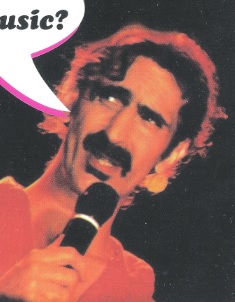 When asked what he regarded as his best quality in writing lyrics, Zappa answered his sense of humor. With the title
of his 1985 CD "Does humor belong in music?" he's referring to this aspect. In general Zappa's lyrics can cover:
When asked what he regarded as his best quality in writing lyrics, Zappa answered his sense of humor. With the title
of his 1985 CD "Does humor belong in music?" he's referring to this aspect. In general Zappa's lyrics can cover:
- Social criticism, tending towards cynicism.
- Absurdities.
- Comedy of a provocative nature.
- Love songs (sixties).
The lyrics can be about anything, but the thing Zappa wouldn't do is expressing personal involvement, fake or real. "Freak out"
(1966) starts right out with a sharp attack on the school system ("Hungry freaks, daddy") and attempts to manipulate
the public opinion ("Brain police"). Absurdities turn up with for instance "Call any vegetable" (1967), where you're advised to
invest in personal friendship with vegetables because they are good for your health and keep you regular.
Zappa did some common love songs in the sixties, but later on took a stand against such lyrics. "Tell me you love me"
(1970),"Babette" (1974) and "Lucille has messed my mind up" (1979) are some of the
last ones he allowed. In 1970 Flo & Eddie joined the band and comedy got introduced. Zappa and Flo & Eddie stimulated each other
into a form of humor that is always on the edge.
The boundaries of humor can be a problem when you play it sharp. I recall a Dutch comedian, Freek de Jonge, telling about a tour he did in the U.S. One act was about racism
and he told about an uncle of his who, as he noticed that his niece was playing with a black doll, said something like
don't play with that, it makes your hands dirty. The idea was to ridicule the narrow-mindedness of racist thought, but a black guy in
the audience stood up saying I don't like this and went. When you know a bit about Freek you know what he means, but
when you don't the reaction of the black guy is just as valid.
Zappa deliberately always looked for the boundaries between humor and offensiveness and the interpretation of it formed a debate during his lifetime and
probably will continue to do so. "For those who in the rush to be offended forgot to listen", he wrote on the backside of
the original "Shut up 'n play yer guitar" album box.
Whether you find Zappa's lyrics entertaining or not is personal and when Neil Slaven in his book calls "The jazz discharge party hats"
tasteless, then I don't have a problem with that. But I'm less pleased when interpretations are getting added in.
In his
biography Barry Miles
is accusing Zappa of sexism, based upon three lyrics from "Tinsel town rebellion", namely "Bamboozled by love", "Easy meat"
and "Fine girl". Within the framework of Zappa's output I think they rather belong to social criticism, being about stupid male behaviour
(beating up women) and stupid female behaviour (walk around in a see-through blouse). "Fine girl" is cryptical. It looks at first
as if it's about enjoying the benefits of a woman doing housekeeping tasks, but when you get at the sentence "She was built like a mule,
her head was kinda flat", it can't be serious no more. "Build like a mule" doesn't fit into sexist thinking.
I go along with
Barry however in the sense that I find these three lyrics plain rude.
The plastic way Zappa described sex and the cynic way he could address himself to the concept of love, has given him something of being women-unfriendly.
Men tend to have less problems with that. "Bobby Brown" is for instance very demeaning about men. It turned out to be a hit in some countries, but I guess
its lyrics got in the way of becoming an international hit. It's also good to be aware that he could do something completely different as on "Cruising with
Ruben and the Jets."
"Does humor belong in music?" knows two covers. The orginal CD used the same photo as on the DVD (above) with
"Does humor belong in music?" in the text balloon. The CD design had this converted into a set-up as if Zappa was looking at an upcoming floodstream
towards him. The other CD cover has another drawing by Cal Schenkel (outtake below).
Baby take your teeth out
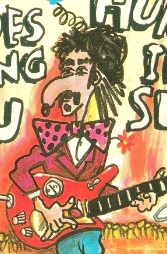 The next example is a friendly song from "Them or us" about false teeth. I think most people will find this song funny, unless
you're born with bad teeth. The song is in D Lydian, beginning instrumentally with the progression I-II-V-III. Next Ike Willis
and Thana Harris sing the main theme over this progression.
The next example is a friendly song from "Them or us" about false teeth. I think most people will find this song funny, unless
you're born with bad teeth. The song is in D Lydian, beginning instrumentally with the progression I-II-V-III. Next Ike Willis
and Thana Harris sing the main theme over this progression.
Baby take your teeth out, opening (midi file).
Baby take your teeth out, opening (transcription).
The lyrics here go as:
"Baby take your teeth out
Try it one time/It'll be fine/You look divine/I will recline
Baby take your teeth out
Try it one time/It'll be fine/You look divine/I will recline
Leave 'em on the kitchen table." Etc.
Zappa was always rapid in applying new techniques. It already started in the early sixties in Paul Buff's studio, when he
got a chance to learn how to use multitrack recording equipment. The sound quality of "Sheik Yerbouti" is for a 1979 album amazing. I know virtually nothing
about recording techniques, but you can look into the Ludwig study for this topic. With "Does humor belong in music" Zappa
immediately responded to the just introduced CD by putting a half of a concert program from the previous 1984 tour on a disc.
The humor from the title in this case not only refers to the lyrics in general but also to the on-stage jokes of the band members among themselves,
like Ike Willis adding in the "hi-ho silver" phrase from a then popular song.
DOES HUMOR BELONG IN MUSIC?
"Does humor belong in music?" is a coherent CD with known pieces in interesting new versions and three unreleased pieces.
The title "Does humor belong in music?" was also used for a DVD, that regarding songs partly overlaps with the CD, but is
entirely taken from a single different concert, namely at the New York Pier.
The idea behind the CD and DVD was an all across selection from the 1984 tour, not specifically the release
of new material, otherwise Zappa could for instance have included "Ride my face to Chicago". Still, when you include the solos and alternative bars,
more than half of the 60 minutes on the CD is unreleased music. Eventually the 1984 tour would become very well covered,
with apart from "Does humor belong in music", about three CDs in the YCDTOSA series and many solos on "Guitar".
CD VERSION
1. Zoot allures (1984)
Though the "Does humor belong to music?" CD begins with four known titles, much on it is new material. In case of these four tracks it concerns alternative bars
for these composition as well as the included guitar solos in three of them. So, in effect, also half of these four tracks is new. The following is a section from the 1984
execution of "Zoot allures".
Zoot allures (1984), 2:12-3:08 (midi file).
Zoot allures (1984), 2:12-3:08 (transcription).
This example includes:
Bars 1-11: the basic idea is the parallel playing of three stacked fifths, followed by a sustained fourth. The improvisations and additional harmonies follow major keys:
F#, G and A. This is also happening on the 1976 "Zoot allures" album. The D# in bar 10 can be seen as passing,
but could also be interpreted as a reason to identify this a switch to A Lydian
(switching between closely related scales is common in Zappa's music). The improvised element, like Zappa soloing in bar 3, are of course specific for the 1984 version.
Bars 12-20: a variation upon the opening theme as included in the "Zoot allures (1976/84)" part of this study.
This variation isn't present in the 1976 version.
The rhythm of bar 13 is different with the chord getting repeated on beat three instead of beat two. While this chord is sustained the bass and drummer continue as:
- bar 14: the first beat is syncopically connected with the previous bar, followed by two dotted quarter notes.
- bars 15-16: normally on beat.
- bars 17-20 are transposing bars 13-16 up with a minor second. With these bars the composition has modulated to A mixolydian, the key of the ensuing guitar solo.
Bars 21-30: start of the guitar solo. All this to the end of the song is 100% specific for the 1984 edition. The 1976 version ends quite differently, as described
in the Zoot allures section of this study.
2. Tinsel-town rebellion
"Tinsel-town rebellion" was first released on the 1981 CD with the same title. See the corresponding section for its main theme. This 1984 version is much entertaining for including a number of quotes from popular pop songs, as there are "I write the songs that make the young girls cry" by Barry Manilow and "I'll tumble 4 ya" by the Culture club.
3. Trouble every day (1984)
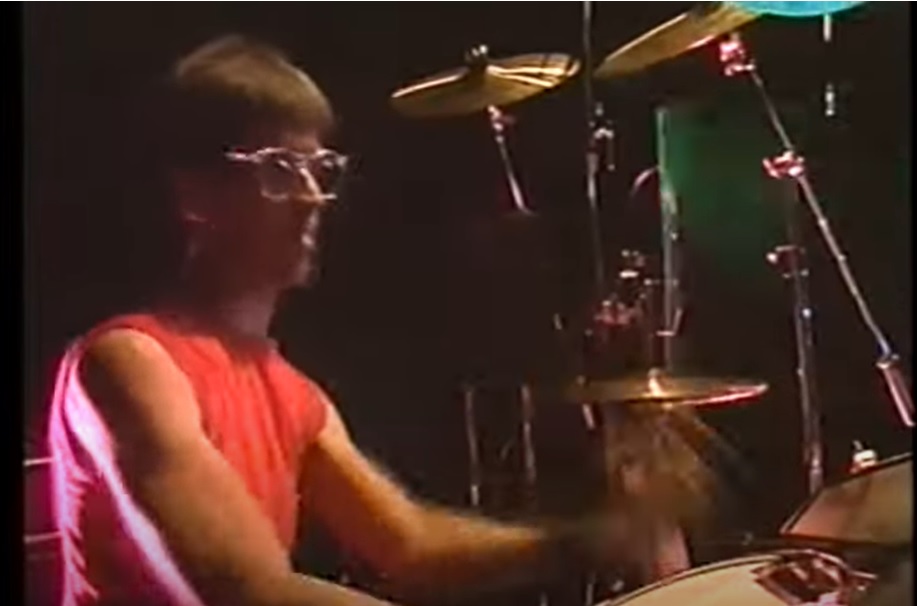 As a composition "Trouble every day" on "Does humor belong in music?" is following the "More trouble every day (1974)" track from "Roxy and elsewhere", but for its title
Zappa returned to simply calling it "Trouble every day" again, the title it had when he wrote the lyrics for this song in 1965 (as released on "Freak out!" in 1966).
Regarding the music the 1965/6 and 1974/1984 versions are entirely different. "More trouble every day (1988)" was also included in the 1988 gig list, titled like this
more accurately in my opinion. See the corresponding sections for outtakes of the guitar solo of this song from 1974 and 1988.
The first example below represents the opening from 1984.
As a composition "Trouble every day" on "Does humor belong in music?" is following the "More trouble every day (1974)" track from "Roxy and elsewhere", but for its title
Zappa returned to simply calling it "Trouble every day" again, the title it had when he wrote the lyrics for this song in 1965 (as released on "Freak out!" in 1966).
Regarding the music the 1965/6 and 1974/1984 versions are entirely different. "More trouble every day (1988)" was also included in the 1988 gig list, titled like this
more accurately in my opinion. See the corresponding sections for outtakes of the guitar solo of this song from 1974 and 1988.
The first example below represents the opening from 1984.
Trouble every day (1984), 0:00-0:29 (midi file).
Trouble every day (1984), 0:00-0:29 (transcription).
- Bar 1: a chord progression: A-G#m-F#m-E for the discant and F#m7-G#m (add 4)-F#m-E (add 2) for the total harmony including the bass.
It's a clear example of Zappa's appetite for rhythmic variation: each beat has its own rhythmic subdivision.
- Bars 2-3: drumroll.
- Bars 4-6: introductory bars, setting the key to F# Dorian.
- Bars 7: repetition of bar 1.
- Bar 8: drumroll.
- Bars 9-10: begin of the verse.
Trouble every day (1984), 2:08-2:37 (midi file).
Trouble every day (1984), 2:08-2:37 (transcription).
This second example contains the chorus (bars 1-4) and start of the soloing. Zappa's desire for rhythmic variation comes out once more
by playing beats 3 and 4 of bars 2 and 4 slightly different. The solo is a pedal note solo, continuing in F# Dorian. Two keyboards
are playing lightly in the background. Peculiar is the presence of a higher E note, that keeps being played in a different tempo, possibly
a tape running. It has no audible meter, I've notated it in standard 4/4 for readability only. A very strange rhythmic experiment, that
Zappa also applied during "In-a-gadda-Stravinsky".
Above to the right: Chad Wackerman playing a drumroll during Trouble every day ("Does humor belong in music?" DVD).
4. Penguin in bondage (1984)
Zappa started performing "Penguin in bondage (1974)"
during the fall tour of 1973. Two full versions are available on the ZFT release "Halloween '73"
and four more on the "Roxy performances". For the actual first release on "Roxy and elsewhere" Zappa edited out a block.
See the Roxy and elsewhere section of this study for the details. On "Does humor belong in music" this composition is present
in its entirety.
Penguin in bondage (1984), 2:19-2:59 (midi file).
Penguin in bondage (1984), 2:19-2:59 (transcription).
A more significant difference is the included guitar solo. In 1973 Zappa was playing over the blues scheme. On this occasion
the solo starts as a G pedal solo. As you can see during bars 1-4 of the example above with just the accompaniment playing, no choice is being made about a particular diatonic scale.
When Zappa starts playing, he is 100 % percent following the whole-tone scale during bars 5-10 (except for one, maybe two incidentally scratched notes).
During bars 11-13 he continues chromatically. There are a few other instances of him using the whole-tone scale present in this study, most notably during the "Sheik Yerbouti
tango" (see the Roxy and elsewhere section for an example and some comment). The Burnt
weeny sandwich section gives an overview of occurring scales in all examples from this study. Chromatic or atonal episodes are normal in Zappa's music in general, but relatively rare during his guitar solos.
In the Shut up 'n play yer guitar section of this study a list of all guitar solos is included with their types and use of scales.
"Penguin in bondage (1988)" also got played during the 1988 tour, appearing on "The best band you never heard in your life" with the addition Swaggart version between brackets.
See the corresponding section for the first six bars of the included guitar solo. In 1988 the band returned to the blues scheme.
5. Hot plate heaven at the Green hotel - For Giuseppe Franco
Zappa's solos are sometimes independent pieces, but normally they are part of songs. Some of the fanatics, the ones
with all the bootlegs and giglists, are therefore able to identify which songs they stem from and even to
correct Zappa's dates occasionally. "Hot plate heaven at the Green hotel" for instance is good for four solos in total.
For the 1984 tour it was agreed upon that halfway the solo the accompaniment would accelerate to double density. What used to be one bar
then becomes two bars. It can be heard this way on the "Does humor belong in music" CD. Since the "For Giuseppe Franco"
solo on "Trance-fusion" is in the same key and doing exactly the same, it is obviously another "Hot plate heaven" solo. The
song re-appeared during the 1988 tour, again with a solo, but this time without an acceleration. It's on "Broadway the hard way"
in total and again a similar solo was released on "Trance-fusion", called "Finding Higgs' Boson". Next are the theme from
"Hot plate heaven at the Green hotel" and a section from "For Giuseppe Franco" with the double density. The song's theme is in
E Dorian and the solo in A Mixolydian (the same notes but with A pedal). In the transcribed section below however the accompaniment is playing
a progression.
Hot plate heaven at the Green hotel, opening (midi file).
For Giuseppe Franco, 2:30 till 2:48 (midi file).
Hot plate heaven at the Green hotel, opening (transcription).
For Giuseppe Franco, 2:30 till 2:48 (transcription).
A couple of times in this study you're getting at the question if you should notate something in 4/4 with triplets or 12/8, in its sounding effect
being the same. This has been discussed at
for instance "I'm the slime" and "Lucille has messed my mind up". In "Hot plate heaven at the Green hotel" its relevance is more than a matter
of notational choice only, because in bars 1-4 Zappa is using two subdivisions simultaneously (straightforward 4/4 and beats using triplets).
6. What's new in Baltimore? (1984)
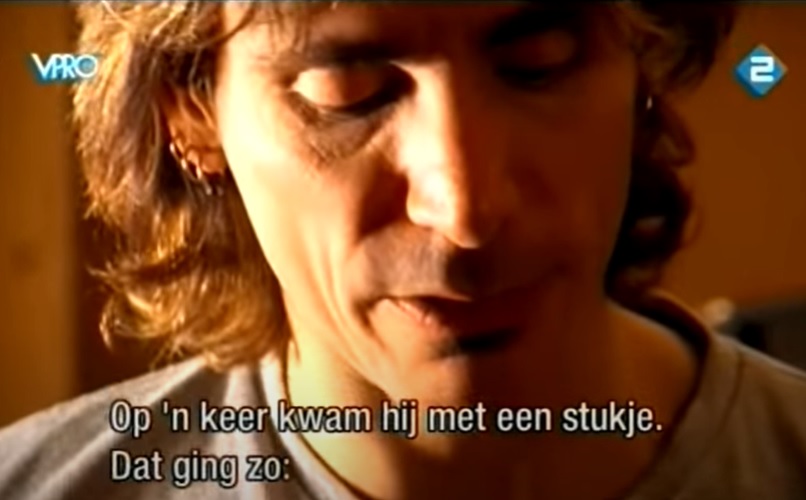 The first half of this song is all composed. See the "What's new in Baltimore? (1982)"
version from The Frank Zappa meets the mothers of prevention section for a description and a note example. The second half, in 1984 beginning with the line
"Hey, what's new in Baltimore", is composed till the guitar solo starts.
The first half of this song is all composed. See the "What's new in Baltimore? (1982)"
version from The Frank Zappa meets the mothers of prevention section for a description and a note example. The second half, in 1984 beginning with the line
"Hey, what's new in Baltimore", is composed till the guitar solo starts.
What's new in Baltimore (1984), 2:48-3:32 (midi file).
What's new in Baltimore (1984), 2:48-3:32 (transcription).
The sung part follows the progression I-IV-V in E. At 2:11 an instrumental 8-bar progression begins: 4 bars with I and VI alternating, followed
by IV-V-VI-V. Zappa begins soloing at bar 5 of this progression. The example above is the first full cycle of him soloing, followed by the first two
bars of the next cycle, which is also the last one. At 3:59 the sung theme returns. A little coda, 4:28 through the end, rounds off this song.
The 1982 and 1984 versions go alike regarding this aspect. On the "Frank Zappa meets the mothers of prevention" CD itself a 1981 recording can be found,
where the sung part isn't present and the soloing is done over a I-IV alternation in E. The 8-bar progression can be seen as an extended, enriched version
of this I-IV alternation. Two chords alternating, however, is much more common in Zappa's music.
Above to the right: Steve Vai commenting upon the time he lived nearby Zappa's house. Zappa could invite him to come over
and jam or to play some music he had just composed, in this case phrases from "What's new in Baltimore?" (still from the
Zappa documentary by Frank Schaeffer, broadcast by VPRO television).
7. Cock-sucker's ball
"Cock-sucker's ball" got recorded by The Clovers as "The rotten cocksuckers' ball". They were a doo-wop group, one of many Zappa liked, singing this title a capella. Because of its lyrics, this song wasn't meant for public release. It apparently circulated as a bootleg recording and eventually reached the market nevertheless. Its origins and recording date are vague. Zappa thus credits it as "traditional", adding himself as the arranger for his 1984 band.
8. WPLJ
Zappa recorded "WPLJ" first for the "Burnt weeny sandwich" album from 1970, where it served as the album opener. It's a cover of single by The Four Deuces, written by Ray Dobard. The abbreviation stands for white port and lemon juice. This is a 1984 live version.
9. Let's move to Cleveland
One of the previously unreleased titles is "Let's move to Cleveland", a sort of a reggae waltz, reggae in 3/4. As more often, Zappa's songs exist a while before they reach
an album. In this case an earlier version of this song was part of the 1976 tour program and got released
on the Zappa Family Trust release "FZ:OZ" as "Canard toujours" (French for always duck for dinner). The set up goes as:
The central themes
- 0:00 Theme 1.
- 0:32 Theme 2.
- 0:56 Theme 1.
- 1:28 Theme 2.
Transcribed below
are its two central themes. The first one, the reggae one, is in C, though with notes being altered frequently. It begins with playing around
the C and G+5 chords, a rather uncommon progression. The second chord already involves an altered note (Eb or D#).
Rhythmically of interest is bar 10,
that has a subdivision into four within a 3/4 bar. The second theme, beginning in bar 13, is in E Dorian.
Let's move to Cleveland, opening (midi file).
Let's move to Cleveland, opening (transcription).
Keyboard and percussion solo
- 1:52 Keyboard solo by Alan Zavod, an example of what Zappa referred to as his "volcano" solos, a musical eruption
(see the YCDTOSA Vol. III booklet at "Chana in the Bushwop").
It has its basis in E Dorian and E Aeolian, with both C natural and C sharp turning up, but rather volatile. Evasions to other keys
and chromatic passages happen frequently.
- 6:36 Percussion and drum solo by Chad Wackerman. Both Alan and Ched get specifically mentioned in the CD leaflet for their contributions
during this song.
Jazz type of keyboard soloing
- 9:34 The solo starts rather chromatic.
- 9:58 Sequence in A Aeolian.
- 10:18 Chord sequence, beginning with a Cadd2 and Gadd4 alternation.
- 10:20 Return of theme 2.
Guitar solo
- 10:52 A pedal note solo with Zappa starting in C Lydian.
- 11:49 Continuing in D Mixolydian.
- 12:49 Return to C Lydian.
Let's move to Cleveland, 12:57-13:21 (midi file).
Let's move to Cleveland, 12:57-13:21 (transcription).
- 13:02 When Zappa is using more than one scale during a solo, they are usually closely related. Above switching between C Lydian and D Mixolydian
only involves moving the pedal note, no notes are getting altered. The situation at the end of this particular guitar solo is exceptional, because the band is moving from
C Lydian to an Ab Lydian type of scale with four notes being altered. The way this is done is extraordinary too: the band is playing chromatically for half a minute to let this transition
take place. The first bar from the example above is the last bar in C Lydian. In the next bars chromaticism is getting the upper hand. Bass player Scott Thunes leaves the C pedal
and Zappa begins playing chromatically. Next Scott Thunes starts improvising a chromatic bass line too.
- 13:33 At this point things are getting stable again, with the band now using a non-standard diatonic scale, Ab-Bb-C-D-Eb-F-Gb.
Something you might call an Ab Lydian variant, with a minor 7th instead of a major 7th.
Return of the central themes
- 15:11 Theme 2.
- 15:34 Theme 1.
- 16:06 Theme 2 with lyrics, "Let's move to Cleveland".
- 16:42 End.
Let's move to Cleveland solos (1984), opening (midi file).
Let's move to Cleveland solos (1984), opening (transcription).
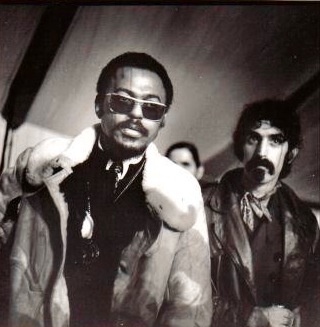 On "YCDTOSA Vol. IV" a block of soloing from this song from the 1984 tour got released as an individual track. Included are solos by Archie Shepp and Alan Zavod.
Above is the opening of this track, 0:00 through 0:36. It contains:
On "YCDTOSA Vol. IV" a block of soloing from this song from the 1984 tour got released as an individual track. Included are solos by Archie Shepp and Alan Zavod.
Above is the opening of this track, 0:00 through 0:36. It contains:
- Pick-up bar: this isn't really a pick-up bar, but a split second from the end of a bar, where Zappa lets this track start.
- Bars 1-2: by the sound of it, you can hear that this is the 1973/4 band playing instead of the 1984 band, though the booklet makes no mention of this.
It's a figure from "The Be-bop tango" that also could got used as a transitory figure between songs, as done again here. See "Smell my beard" from the YCDTOSA Vol. II section
for an example from 1974 and the details.
- Bars 3-6: a vamp in 12/8 starts. It's in C Lydian with II-I as chord progression. I've notated this as 4/4 with triplets and no F# in the presets to make it better
readable in combination with bars 1-2. Zappa introduces Archie Shepp. Shepp is a well-known jazz saxophone player and music teacher. He knew Zappa since the sixties.
To the right a photo of them from that time, downloaded from the killuglyradio site (the photographer doesn't get mentioned).
- Bars 7-13: first 7 bars from the solo by Shepp. He's using altered notes, as well as playing through C major, rather than C Lydian.
10. Whippin' post
The third cover song on this album, "Whippin' post", was released earlier on "Them or us". It includes a solo over the "For Duane" vamp, that you can find on "Guitar".
Dweezil Zappa, at that time 15 years old, participated in this tour for playing guitar solos. He begins the soloing during this title. After a while his father
joins in, playing together. See "Bavarian sunrise" from the Trance-fusion section for a note example of them jointly soloing.
DVD VERSION
He's so gay - Bobby Brown
I'll continue with two mainstream pop-songs that can be found on the DVD version only. Regarding its rhythm "He's so gay" is for
Zappa-standards unusually straightforward. Not only is the meter regular 4/4, about everything is played on beat. Zappa may
complain about most pop music going boom-tick-boom-tick in the Real Frank Zappa book. Something that can be confusing however, is that whenever
you find Zappa talking about something he dislikes, you'll also find examples of him doing exactly that. In this bottom section it's about
rhythmic and harmonic conventions. What makes "He's so gay"
sound interesting, specifically on the "Thing-Fish" studio version, is the way the bass part is handled. I don't know how exactly Zappa created
this effect, but is has the accent fluctuating between the left and right channel of the stereo field plus it's made up of more
than one single bass line. I've notated it via three staves, one for the left channel, one for the right channel and one for the middle.
Zappa about always looked for a stable fully deployed stereo field, so this is something unusual. Already around 1970 he started using the possibility of double-channeling a guitar,
with the left channel reacting a bit different to the instrument than the right channel. So he continued playing in stereo ever since. Only during the
"Burnt weeny sandwich" guitar solo he let an instrument move between right and left via the simple method of using the stereo buttons from the control panel.
What's done here with the bass line is a much more sophisticated manner of letting an instrument vacillate.
He's so gay (Thing-Fish), section (midi file)
He's so gay (Thing-Fish), section (transcription).
In case of "Bobby Brown", Zappa's choice for following pop-standards paid off, maybe more than he had expected. With "Baby snakes" on the other side it became a hit, though only in some specific
European countries (see the screenhot below from swedishcharts.com). The lyrics about a sexually degenerated male got in the way of getting it aired in English
speaking countries. With hindsight the song could better have had conventional lyrics as well.
Below follows the construction of these two songs on DVD, mostly global, but filled in with details for the transcribed sections:
He's so gay
- 0:00 Intro. The song is in Bb.
- 0:05 Theme 1
The trancribed section from "Thing-Fish" from above corresponds with the DVD at 0:51 for its starting point. Bars 1-5 are the tail of theme 1. The spoken
words in staff 1 are Brown Moses commenting.
- 1:00 Theme 2
Bars 6-9 contain phrases 1 and 2 from theme 2. Harmonically the song so far mostly has been a series of triads in Bb. During phrase 2 you can see
some altered notes turning up. In bar 8 the Bb chord moves down chromatically with a minor second to the A chord. Bar 9 contains the progression
Bb-Cm7 (plus Ab)-Bb7-Fm (plus B). So Zappa has briefly modulated here to Bb Mixolydian. Next the example from above stops and phrase 1 gets repeated, followed
by a variation upon phrase 2 and a longer coda.
- 1:31 Theme 1 returns.
- 1:57 Theme 3.
- 2:11 Finale. While so far the lyrics of this song have been making fun of gay life, at this point it's given a comic twist. It ends with saying "maybe later we'll
all be gay". The example below jumps in at 2:16. It ends with the chord progression I-II 7th-I 7th in Bb (bars 3-6). Ike Willis is starting with an A in bar 5, but lets
it resolve to Bb. Also the keyboard part in staff 5 is moving freely through the scale, but
neatly ending with the Bb chord.
- 2:26 Bars 6-9. Citation from the Culture Club song with the same title. The melody and chord progression are a variation upon their version.
Zappa is using I-II-III-III 7th. If I'm hearing it correctly the last chord has an extra Bb added to it.
- 2:34 Bars 10-11. Transition towards "Bobby Brown". The "He's so gay" track on YCDTOSA VI CD is from the same concert as on the DVD, but doesn't include this transition.
- 2:37 Bars 12-15. Intro in C for "Bobby Brown", still included in the "He's so gay" track.
He's so gay - Bobby Brown, transition (midi file)
He's so gay - Bobby Brown, transition (transcription).
Bobby Brown
- 0:00 Verse. Beat 4 of bar 15 is used as the pick-up bar for "Bobby Brown". Zappa starts singing theme 1 all by himself at first. The general outlines of
"Bobby Brown" have been described briefly by Wolfgang Ludwig (see below). I'm filling it in with some details from the "Does humor belong in music" DVD.
The song is in C and theme 1 follows the progression I-VI-II 7th-V. The transcription above stops with bar 20 with the II 7th chord.
- 0:25 Refrain.
- 0:42 Verse.
- 1:08 Refrain. At this point the last example below starts. Its chord progression goes as:
Bars 1-2: IV sustained with the chorus singing IV-III-II-I-IV-III-II over it.
Bars 3: III 7th sustained by bass, keyboard and chorus. Zappa sings the lyrics alone.
Bar 4: VI sustained. Zappa continues solo.
Bar 5: II 7th sustained. Zappa now continues with notes of the melody, while the chorus is singing A and C steadily. The rhythm is speech-influenced
and can get syncopic at various points. Here you've got a pretty heavy syncope between bars 5 and 6. Also the drummer follows this (main beats
are included for these bars). Also bar 8 looks a bit strange on paper.
Bar 6-8: V sustained. Here the chorus is moving rather freely. Zappa sings the lowest notes, the melody itself. The higher notes are sung by Ike Willis,
Ray White and Bobby Martin, forming improvised harmonies. In bars 7-8 all four are following their own melodic line. Basically the "Does humor belong in music"
version and the original on "Sheik Yerbouti" are the same. It's details like these specific notes by the chorus, that form the difference.
Bars 9-10: Other than on Sheik Yerbouti, you're here having a unisono G note following the "I wonder, wonder" text. On "Sheik Yerbouti" the text is also
only using the G, but the accompaniment follows the progression V-IV-III-V and the bass is descending from G to D to ultimately the C of the verse.
- 1:24 Verse. The example below stops here after the first two bars.
- 1:49 Refrain.
- 2:28 End.
Bobby Brown, section (midi file)
Bobby Brown, section (transcription).
Bobby Brown, analysis by W. Ludwig.
There's a number of ways for identifying chords. In the Ludwig study you'll sometimes find a coding, used in Germany only. In my study you'll also find different methods,
so a brief overview might at this point be handy for knowing what the German symbols stand for. Even so there are more notational variants.
Chord identification with numbers, related to scales and their tonic:
- In Europe chords are identified by their root note, corresponding with a scale step, identified with the Roman numbers I to VII. Chords are always interpreted
as derived from stacking thirds. Two thirds form a 5th chord, three a 7th chord etc. Not all thirds have to be present.
- In the US the same idea gets applied with an extra distinction. Major chords use an uppercase, minor chords a lowercase Roman number.
- The German variant uses the series T-Sp-Dp-S-D-Tp-(VII) instead of I-VII. T stands for tonic, Sp for subdominant parallel etc.
Identification of diatonic chords by their root note plus symbols for the type of chord:
This is the common method in songbooks. The major triad on C gets the symbol "C", the minor triad "Cm", the dominant 7th "C7" etc.
Chords in general:
- By simply mentioning the individual notes in the chord, for instance F-C-E-G-B.
- By naming the intervals as the number of minor seconds between the subsequent notes. F-C-E-G-B then becomes 7-4-3-4.
- This can be refined by identifying the octave the notes are in as well. The central C gets called C4. When you move this C an octave down you get C3, and
by going up you get C5. By the standard that A4 has the frequency of 440 Hz, chords can be identified in an absolute manner.
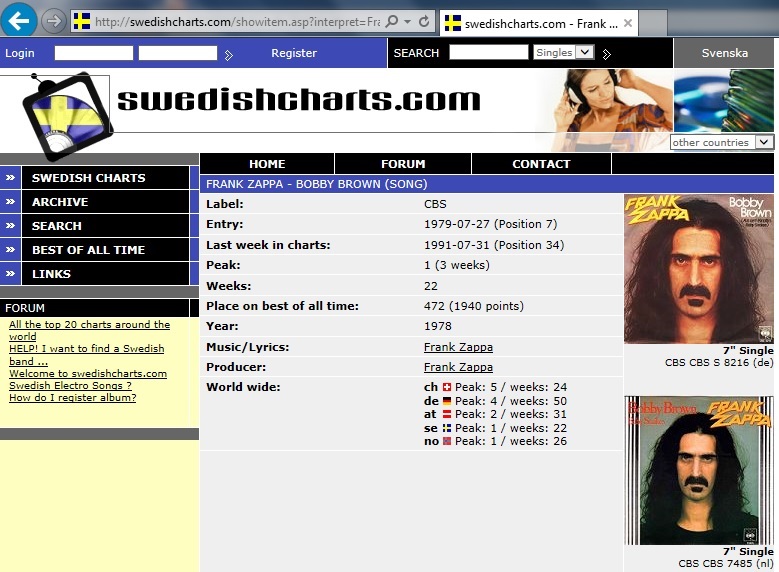
Other tracks from the Does humor belong in music? DVD
Other titles, appearing on the DVD version only:
- "The dangerous kitchen" is or used to be available via Barfko Swill (transcription by Steve Vai).
A sample is included in this study.
- "Keep it greasy": an excerpt from an earlier 1976 version is present in the
FZ:OZ section.
- "Honey, don't you want a man like me?":
four versions are coming by in the YCDTOSA section.
- The scores from "Dinah-Moe Humm" and "Cosmic debris" are available via the Hal Leonard guitar books series (see the Overnite sensation and Apostrophe sections for samples).
